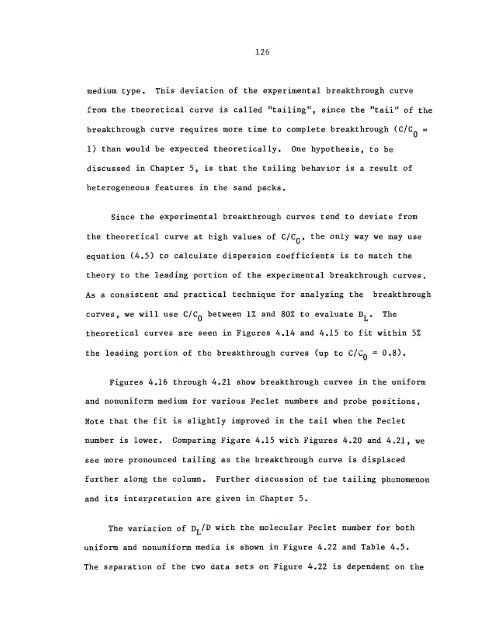longitudinal dispersion in nonuniform isotropic porous media
longitudinal dispersion in nonuniform isotropic porous media
longitudinal dispersion in nonuniform isotropic porous media
Create successful ePaper yourself
Turn your PDF publications into a flip-book with our unique Google optimized e-Paper software.
126<br />
medium type. This deviation of the experimental breakthrough curve<br />
from the theoretical curve is called "tail<strong>in</strong>gll, s<strong>in</strong>ce the "tail il of the<br />
breakthrough curve requires more time to complete breakthrough (C/C O =<br />
1) than would be expected theoretically. One hypothesis, to be<br />
discussed <strong>in</strong> Chapter 5, is that the tail<strong>in</strong>g behavior is a result of<br />
heterogeneous features <strong>in</strong> the sand packs.<br />
S<strong>in</strong>ce the experimental breakthrough curves tend to deviate from<br />
the theoretical curve at high values of CIC O ' the only way we may use<br />
equation (4.5) to calculate <strong>dispersion</strong> coefficients is to match the<br />
theory to the lead<strong>in</strong>g portion of the experimental breakthrough curves.<br />
As a consistent and practical technique for analyz<strong>in</strong>g the breakthrough<br />
curves, we will use CIC O between 1% and SO% to evaluate D L • The<br />
theoretical curves are seen <strong>in</strong> Figures 4.14 and 4.15 to fit with<strong>in</strong> 5%<br />
the lead<strong>in</strong>g portion of the breakthrough curves (up to CIG O = O.S).<br />
Figures 4.16 through 4.21 show breakthrough curves <strong>in</strong> the uniform<br />
and <strong>nonuniform</strong> medium for various Peclet numbers and probe positions.<br />
Note that the fit is slightly improved <strong>in</strong> the tail when "the Peclet<br />
number is lower. Compar<strong>in</strong>g Figure 4.15 with Figures 4.20 and 4.21, we<br />
see more pronounced tail<strong>in</strong>g as the breakthrough curve is displaced<br />
further along the column. Further discussion of the tail<strong>in</strong>g phenomenon<br />
and its <strong>in</strong>teq>retaLion are given <strong>in</strong> Chapter 5.<br />
The variation of DL/D with the molecular Peclet number for both<br />
uniform and <strong>nonuniform</strong> <strong>media</strong> is shown <strong>in</strong> Figure 4.22 and Table 4.5.<br />
The s2paration of the two data sets on Figure 4.22 is dependent on the

















